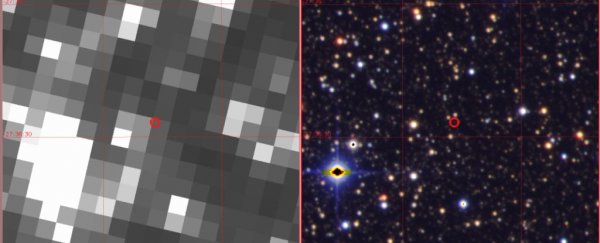An exoplanet a whopping 17,000 light-years from Earth has been found hiding in data collected by the now-retired Kepler Space Telescope.
It's the most distant world ever picked up by the planet-hunting observatory, twice the distance of its previous record. Fascinatingly, the exoplanet is almost an exact twin of Jupiter – of similar mass, and orbiting at almost the same distance as Jupiter's distance from the Sun.
Named K2-2016-BLG-0005Lb, it represents the first exoplanet confirmed from a 2016 data run that detected 27 possible objects using a technique called gravitational microlensing rather than Kepler's primary detection method. The discovery has been submitted to the Monthly Notices of the Royal Astronomical Society, and is available on preprint server arXiv.
"Kepler was never designed to find planets using microlensing so, in many ways, it's amazing that it has done so," said astronomer Eamonn Kerins of the University of Manchester.
The Kepler spacecraft was instrumental in blowing the field of exoplanet astronomy wide open. It launched in 2009, and spent nearly 10 years hunting for planets outside the Solar System, or exoplanets. During that time, its observations revealed over 3,000 confirmed exoplanets, and another 3,000 candidates.
Its technique is ingeniously and deceptively simple. Kepler stared at fields of stars, optimized for detecting the faint, regular dips in starlight that suggest an exoplanet is in orbit around a star. This is called the transit methodm, and it's good for finding larger nearby exoplanets orbiting close to their stars.
Microlensing is a little trickier, leveraging a quirk of gravity and a chance alignment. The mass of a body such as a planet creates a gravitational curvature of space-time around it. If that planet then passes in front of a star, the curved space-time basically acts like a magnifying glass that very faintly and briefly causes the starlight to brighten.
Gravitational microlensing is very good at finding exoplanets a long distance from Earth, orbiting their stars at quite large distances, down to very small planet masses. The most distant galactic exoplanet discovered to date was picked up by microlensing, an Earth-mass world 25,000 light-years away.
Since Kepler is optimized for detecting changes in starlight, a team of researchers led by the University of Manchester recently thought to look at the Kepler data for microlensing events, from an observing window over several months in 2016. They identified 27 events, five of which were entirely new, not yet identified in data from ground-based telescopes.
"To see the effect at all requires almost perfect alignment between the foreground planetary system and a background star," Kerins explained.
"The chance that a background star is affected this way by a planet is tens to hundreds of millions to one against. But there are hundreds of millions of stars towards the center of our galaxy. So Kepler just sat and watched them for three months."
One of the five events was K2-2016-BLG-0005Lb, and it looked promising for an exoplanet orbiting a star. So the team searched datasets from five ground-based surveys that were looking at the same patch of sky at the time Kepler was, to corroborate their signal.
They found that Kepler observed the signal slightly earlier, and for slightly longer, than the five ground-based surveys. This combined dataset allowed the team to determine that the exoplanet is around 1.1 times the mass of Jupiter, orbiting its star at a circular distance of 4.4 astronomical units. Jupiter's average distance from the Sun is 5.2 astronomical units.
"The difference in vantage point between Kepler and observers here on Earth allowed us to triangulate where along our sight line the planetary system is located," Kerins said.
"Kepler was also able to observe uninterrupted by weather or daylight, allowing us to determine precisely the mass of the exoplanet and its orbital distance from its host star. It is basically Jupiter's identical twin in terms of its mass and its position from its Sun, which is about 60 percent of the mass of our own Sun."
Although we don't currently have more data on the system, this finding has implications for our search for extraterrestrial life. There's evidence to suggest that Jupiter may have played an instrumental role in the conditions that allowed life to emerge and thrive on Earth; finding Jupiter analogues orbiting distant stars could be a way to identify these conditions.
The fact that Kepler, an instrument not designed for microlensing, was able to make this sort of detection, bodes well for upcoming instruments that will be designed for microlensing. NASA's Nancy Grace Roman Space Telescope, scheduled to launch in the next five years, will be looking for microlensing events, as will ESA's Euclid, scheduled for a launch next year.
These detections could revolutionize our understanding of exoplanets.
"We'll learn how typical the architecture of our own solar system is," Kerins said. "The data will also allow us to test our ideas of how planets form. This is the start of a new exciting chapter in our search for other worlds."
The research has been submitted to the Monthly Notices of the Royal Astronomical Society and is available on arXiv.
